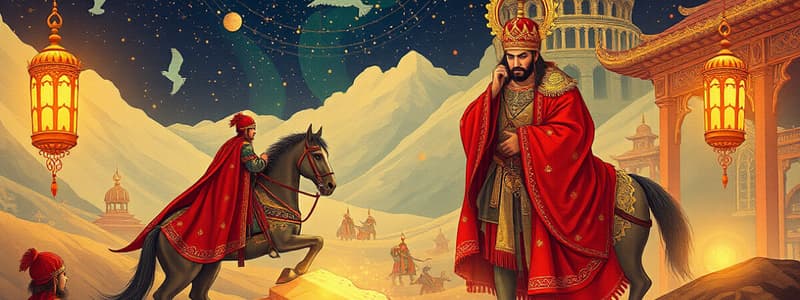Podcast
Questions and Answers
What was the Golden Horde also known as?
What was the Golden Horde also known as?
Kipchak Khanate
Who is credited with creating the Golden Horde?
Who is credited with creating the Golden Horde?
- Ghenghis Khan
- Kublai Khan
- Batu Khan (correct)
- Tamerlane
Which countries did the Golden Horde rule over?
Which countries did the Golden Horde rule over?
Ukraine, Kazakhstan, Russia, and Caucasus
The capital of the Golden Horde was ______.
The capital of the Golden Horde was ______.
What was the main natural resource used by the Golden Horde?
What was the main natural resource used by the Golden Horde?
What was one major contribution of the Mongols after Ghenghis Khan's death?
What was one major contribution of the Mongols after Ghenghis Khan's death?
What caused the downfall of the Golden Horde?
What caused the downfall of the Golden Horde?
In what year did Muscovite Russia break free from Tatar control?
In what year did Muscovite Russia break free from Tatar control?
What is one tradition in the Mongol Empire mentioned?
What is one tradition in the Mongol Empire mentioned?
What can we learn from the history of the Golden Horde?
What can we learn from the history of the Golden Horde?
Flashcards are hidden until you start studying
Study Notes
Introduction
- The Golden Horde, also known as Kipchak Khanate, was a Mongol empire established by Batu Khan, a grandson of Genghis Khan.
- Spanning from the 1240s to the early 1500s, it was significant in the control of several regions.
Geography
- The territory of the Golden Horde included parts of Ukraine, Kazakhstan, Russia, and the Caucasus region.
- Cattle served as a primary resource, providing meat and dairy for sustenance.
- Hunting techniques included targeting rabbits, deer, wild boar, and occasionally rodents in times of scarcity.
- Horses were crucial for transportation during the 1240s to 1500s, serving as the primary means of travel.
- Sarai Batu was the capital, interpreted as "Batu's Palace," with a population of approximately 600,000.
Contributions
- After Genghis Khan's death in 1227, the Mongols introduced paper money, made from Chinese silver, a major innovation that influenced global economies.
- The Department of Monetary Affairs was established in 1253 to manage the circulation of paper money.
- Arranged marriages were a common tradition, with women often given to men irrespective of choice.
Downfall
- The Golden Horde's decline occurred in the 1440s due to civil war, leading to fragmentation into eight khanates.
- Notable khanates included the Siberia Khanate, Qasim Khanate, Khanate of Kazan, Khanate of Astrakhan, Kazakh Khanate, Uzbek Khanate, and the Khanate of Crimea.
- Muscovite Russia emerged as the strongest, gaining independence from Tatar control in 1480.
Conclusion
- The Golden Horde's impact on Asian history remains significant, offering both positive and negative contributions.
- Understanding its legacy is essential for appreciating historical context and lessons from the past.
Studying That Suits You
Use AI to generate personalized quizzes and flashcards to suit your learning preferences.




